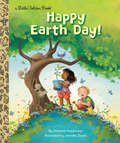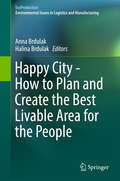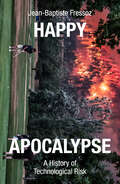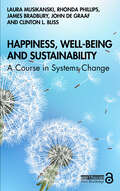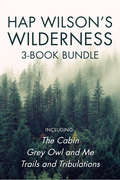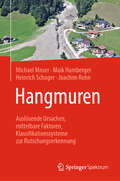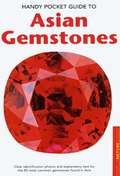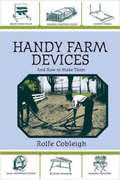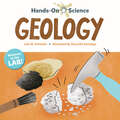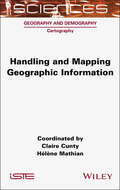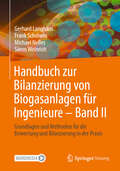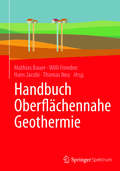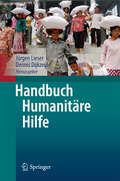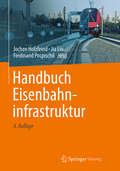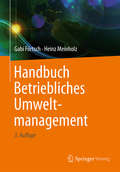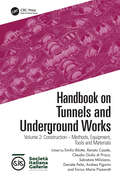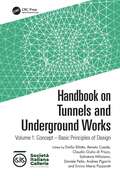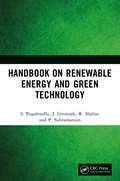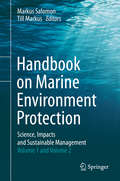- Table View
- List View
Happy-Go-Local
by Linsly DonnellyCSAs or farmers' markets?Upcycling or freecycling?Carpools or staycations?All of the above?They're all great choices - but how do you decide where your family's time and energy is best spent?In Happy-Go-Local, Linsly Donnelly shares countless ideas from her own experience in living locally to help you raise a happy and sustainable family. From community swaps to cooking co-ops, her approachable, step-by-step style will inspire you to make changes that bring your family, neighborhood, and town together - one compost pile at a time.Featuring interviews and tips from professionals in the sustainable movement, this all-in-one guide takes the guesswork out of living locally - and is one item you won't want to recycle!
Happy-Go-Local
by Linsly DonnellyCSAs or farmers' markets?Upcycling or freecycling?Carpools or staycations?All of the above?They're all great choices - but how do you decide where your family's time and energy is best spent?In Happy-Go-Local, Linsly Donnelly shares countless ideas from her own experience in living locally to help you raise a happy and sustainable family. From community swaps to cooking co-ops, her approachable, step-by-step style will inspire you to make changes that bring your family, neighborhood, and town together - one compost pile at a time.Featuring interviews and tips from professionals in the sustainable movement, this all-in-one guide takes the guesswork out of living locally - and is one item you won't want to recycle!
Happy Earth Day! (Little Golden Book)
by Deborah HopkinsonThis fact-filled Little Golden Book is about Earth Day—what it is and why it's important—and offers suggestions for actions kids can take to help protect and heal our planet.Earth Day is celebrated on April 22 each year, but this Little Golden Book about the history and importance of Earth Day will inspire children to appreciate our planet each and every day! Includes directions for family-friendly projects, such as composting, growing baby carrots on a windowsill, making a bug hotel, and more.
Happy City - How to Plan and Create the Best Livable Area for the People
by Anna Brdulak Halina BrdulakThis book presents multi-sector practical cases based on the author's own research. It also includes the best practice, which could serve as a benchmark for the creation of smart cities. The global urbanisation index, i. e. , the ratio of city dwellers to the total population, has been steadily increasing in recent years. It is highest in the Americas, followed by Europe, Asia and Africa. The city of the future will combine the intelligent use of IT systems with the potential of institutions, companies and committed, creative inhabitants. The administrative boundaries of today's cities put certain constraints on their further growth, but in the future these boundaries will no longer be as relevant. Cities in Europe face the challenge of reconciling sustainable urban development and competitiveness - a challenge that will likely influence issues of urban quality such as the economy, culture, social and environmental conditions, changing a given city's profile as well as urban quality in terms of its composition and characteristics.
Happy Apocalypse: A History of Technological Risk
by Jean-Baptiste FressozHow risk, disasters and pollution were managed and made acceptable during the Industrial RevolutionBeing environmentally conscious is not nearly as modern as we imagine. As a mode of thinking it goes back hundreds of years. Yet we typically imagine ourselves among the first to grasp the impact humanity has on the environment. Hence there is a fashion for green confessions and mea culpas.But the notion of a contemporary ecological awakening leads to political impasse. It erases a long history of environmental destruction. Furthermore, by focusing on our present virtues, it overlooks the struggles from which our perspective arose.In response, Happy Apocalypse plunges us into the heart of controversies that emerged in the eighteenth and nineteenth centuries around factories, machines, vaccines and railways. Jean-Baptiste Fressoz demonstrates how risk was conceived, managed, distributed and erased to facilitate industrialization. He explores how clinical expertise around 1800 allowed vaccination to be presented as completely benign, how the polluter-pays principle emerged in the nineteenth century to legitimize the chemical industry, how safety norms were invented to secure industrial capital and how criticisms and objections were silenced or overcome to establish technological modernity.Societies of the past did not inadvertently alter their environments on a massive scale. Nor did they disregard the consequences of their decisions. They seriously considered them, sometimes with dread. The history recounted in this book is not one of a sudden awakening but a process of modernising environmental disinhibition.
Happiness, Well-being and Sustainability: A Course in Systems Change
by Rhonda Phillips John de Graaf Laura Musikanski James Bradbury Clinton L. BlissHappiness, Well-being and Sustainability: A Course in Systems Change is the first textbook bridging the gap between personal happiness and sustainable social change. The book provides a guide for students to increase their skills, literacy and knowledge about connections between a sense of well-being and systems change. Further, it can help students live a life that brings them happiness and contributes to the well-being of others and the sustainability of our planet. The book is presented in seven chapters covering the subjects of systems thinking, personal and societal values, measuring happiness, human needs, ecological sustainability and public policy. In addition, each section includes engaging exercises to empower students to develop their own ideas, prompts for group discussion, suggestions for additional research and an extensive list of resources and references. The book is written in the context of systems thinking with a style that is approachable and accessible. Happiness, Well-being and Sustainability provides essential reading for students in courses on happiness, social change and sustainability studies, and provides a comprehensive framework for instructors looking to initiate courses in this field.
Hap Wilson's Wilderness 3-Book Bundle: The Cabin / Grey Owl and Me / Trails and Tribulations
by Hap WilsonNoted traveller and environmentalist Hap Wilson shares accounts of his lifelong involvement with wilderness living within the Canadian Shield. Wilson knows better than most how to live in the woods. As park ranger, canoe guide, outfitter, trail builder, and environmental activist, he learned from firsthand experience that nature can neither be beaten or tamed.This three-book bundle includes: The Cabin: A Search for Personal Sanctuary Noted environmentalist Hap Wilson takes us along a wilderness trail replete with snags and pitfalls, through mishaps, tears, and laughter. Grey Owl and Me: Stories From the Trail and Beyond Hap Wilson is back for another journey. Nurtured by the writings of Grey Owl, Wilson adopted a similar lifestyle to the 1930s conservationist but with his own twists and turns. Wilson recounts the early days of winter camping, takes readers to some of his favourite places, and shares intimate secrets of wilderness living. Trails and Tribulations:Confessions of a Wilderness Pathfinder Noted northern traveller Hap Wilson shares accounts of his lifelong involvement with wilderness living within the Canadian Shield. A park ranger, canoe guide, and environmental activist, Wilson takes the reader on a journey through natural settings ranging from austere to mysterious and breathtaking.
Hangmuren: Auslösende Ursachen, mittelbare Faktoren, Klassifikationssysteme zur Rutschungserkennung
by Michael Moser Joachim Rohn Maik Hamberger Heinrich SchogerDieses Buch bietet eine umfassende Analyse der Ursachen und Auswirkungen von Hangmuren, die durch Starkniederschläge ausgelöst werden, und untersucht dabei detailliert die geotechnischen und morphologischen Faktoren, die zu diesen Naturereignissen führen. Anhand von Fallstudien aus Kärnten, Tirol, der Schweiz und Norditalien werden die komplexen Zusammenhänge zwischen Niederschlagsereignissen und Hangbewegungen aufgezeigt. Wichtige Konzepte des Buches umfassen die geotechnischen Eigenschaften von Lockergesteinen, Hangneigung, Morphologie und Vegetation. Kapitel zu den auslösenden Ursachen, zu Geometrische Daten der Hangbewegungen und zu Stabilitätsbetrachtungen flachgründiger Lockergesteinsrutschungen beleuchten die Mechanismen hinter den Hangmuren. Zudem wird mit den Klassifikationssystemen zur Rutschungserkennung ein innovativer Ansatz zur Vorhersage und Erkennung von Rutschungen vorgestellt. Die Untersuchung der Ereignisse von 1965/66 im Lesachtal bis hin zu den jüngsten Hangmuren 2024 zeigt die Dringlichkeit und Relevanz dieses Themas. Die Zielgruppen des Buches sind Forscher, Geologen, Ingenieure und Fachleute im Bereich der Geotechnik sowie Entscheidungsträger in der Katastrophenvorsorge. Es bietet wertvolle Einblicke in die Mechanismen von Hangmuren und liefert praxisnahe Methoden zur Risikoanalyse und Prävention. Leser mit einem wissenschaftlichen oder technischen Hintergrund werden durch detaillierte Fallstudien und interdisziplinäre Ansätze profitieren. Sie lernen nicht nur die theoretischen Grundlagen kennen, sondern erhalten auch praktische Werkzeuge zur Anwendung in Forschung und Praxis.
Handy Pocket Guide to Asian Gemstones
by Carol ClarkGemstones, both mythical and real, are deeply embedded in the arts, religions and cultures of Asia. This handy pocket guide provides an excellent introduction to the full range of superb gemstones mined and processed in the region, their physical characteristics, historical importance and countries of origin. Stunning color photographs and informative text by noted writer on gemstones Carol Clark, will delight both gem collectors and lovers of fine jewelry alike.
Handy Pocket Guide to Asian Gemstones
by Carol ClarkGemstones, both mythical and real, are deeply embedded in the arts, religions and cultures of Asia. This handy pocket guide provides an excellent introduction to the full range of superb gemstones mined and processed in the region, their physical characteristics, historical importance and countries of origin. Stunning color photographs and informative text by noted writer on gemstones Carol Clark, will delight both gem collectors and lovers of fine jewelry alike.
Handy Farm Devices and How to Make Them
by Rolfe CobleighDating from the Golden Age of American Farming, this volume is both a tribute to days gone by and a resource for present day homeowners, farmers, and ranchers striving toward greater self-sufficiency. Here you will find hundreds of clever ways to transform those odds and ends that might seem like junk into very useful gadgets and tools, from a treadmill that can power a dairy separator and churn, to a drinking fountain for chickens. Other devices include a rig for moving large trees; a self-feeder for bees; a hand garden cultivator; and gates that lift over snowdrifts. It's full of useful illustrations and includes a whole section of tried-and-true tips.
Hands-On Science: Geology (Hands-On Science)
by Lola M. SchaeferPress Here meets Bill Nye the Science Guy in this interactive STEM picture book about rocks, minerals, and Earth science.Welcome to the geology lab! In this interactive picture book, young scientists use their imagination to bring experiments to life. They slide tectonic plates together to create earthquakes, blow on a mountain to make a volcano erupt, and press their hands in mud to make a fossil. After predicting what will happen next, eager readers turn the page to see the results.Educator and author Lola M. Schaefer draws on her years in the classroom to make science fun and accessible. Back matter includes a simple experiment for investigating rocks and minerals in the real world.
Handling of Geospatial Data with QGIS: A Basic and Practical Visual Learning Material for Geospatial Data Processing, Analysis and Visualisation (Springer Textbooks in Earth Sciences, Geography and Environment)
by Yuji Murayama Ko Ko LwinThis textbook introduces QGIS software and shows how to use it step-by-step using many illustrations. Some topics can be understood by viewing a figure, without the need to read texts. The purposes, functions, and potential applications of the software are also explained. The book is a good first step to understand the theories on GIS through practice. With the increasing use of GIS (geographic information systems/science) in the arenas of education and research, the need for this book is becoming apparent. Students and researchers in various disciplines have noted that GIS is a powerful tool for acquiring, exploring, analyzing, and visualizing geospatial data for their work. Some of their data come from geospace in the form of coordinates; of course, we are living in a world with coordinates. Wherever we move, whatever we do, we can be located by coordinates, as everything is at rest, moving, or happening in space. Although GIS has been used for a long time in many professional fields, such as land surveying, urban and regional development, transportation planning, hydrology, environmental management, and so on, the use of GIS by the public is fairly recent. Following the emergence of global positioning systems, wireless communication technologies, and nano-scale microchip technologies, GIS is now a commonplace. Together with advanced technologies and user-friendly software development, the use of GIS has moved from desktop to laptop to mobile devices, and from professionals to academics to the public. Moreover, QGIS is increasingly used by students, researchers, and professionals on a daily basis due to its free and open-source geographic information system, community-based software development, user-friendliness, and the many plugins that are available to enhance the capabilities of this software.
Handling and Mapping Geographic Information (ISTE Consignment)
by Hélène Mathian Claire CuntyWith the increasing proliferation of data and the systematization of geographic information referencing, maps are now a major concern – not only for specialists, but also for urban planning and development organizations and the general public. However, while producing a map may seem straightforward, the actual process of transforming data into a useful map with a specific purpose is characterized by a series of precise operations that require knowledge in a variety of fields: statistics, geography, cartography and so on. Handling and Mapping Geographic Information presents a wide range of operations based on a variety of examples. Each chapter adopts a different approach, explaining the methodological choices made in relation to the theme and the pursued objective. This approach, encompassing the entire map production process, will enable all readers, whether students, researchers, teachers or planners, to understand the multiple roles that maps can play in the analysis of geographical data.
Handbuch zur Bilanzierung von Biogasanlagen für Ingenieure - Band II: Grundlagen und Methoden für die Bewertung und Bilanzierung in der Praxis
by Gerhard Langhans Frank Scholwin Michael Nelles Sören WeinrichAus dem breiten Anwendungsfeld für Biogasgewinnung ergeben sich mannigfaltige Anforderungen, die den Praktiker oft vor spezielle Herausforderungen stellen. Hier setzt das Buch an und konzentriert sich auf die in der Praxis relevanten technischen Herausforderungen der Technologie und bereitet die wissenschaftlichen Grundlagen der anaeroben Prozessführung für Herausforderungen in der Praxis auf (Anwendbarkeit, Interpretation der Messgrößen, Zuverlässigkeit von Bewertungsmethoden) und stellt zur schnellen Abschätzung u. a. Nomogramme und Parametersammlungen zur Verfügung.
Handbuch Oberflächennahe Geothermie
by Willi Freeden Mathias Bauer Hans Jacobi Thomas NeuDas Handbuch vermittelt die Grundlagen wie das thermische Regime der Erde, die oberflächennahe Geologie, geologisch-geophysikalische Grundlagen, zugrunde liegende mathematische Methoden, Risikomanagement und Bohrtechniken. In den angewandten Kapiteln geht es konkret um Geothermieprojekte aus der Sicht eines Bauherren, u.a. um Heizlastberechnung und die hydraulische Abgleichung, daneben um das Projektmanagement, zu berücksichtigende Umweltaspekte, Finanzierung und Fördermöglichkeiten und die Dimensionierung von Anlagen. Auch Verfahrenstechnische Grundlagen, die Maschinentechnik, die Qualitätssicherung und Fragen der Kommunikation und Akzeptanz wie auch der Arbeitssicherheit und des Gesundheitsschutzes werden behandelt. Auch wenn der Schwerpunkt des Handbuches auf Deutschland, Österreich und der Schweiz liegt, so wird auch auf die Oberflächennahe Geothermiebranche weltweit eingegangen und Herausforderungen wie auch Chancen und Perspektiven aufgezeigt.
Handbuch Humanitäre Hilfe
by Jürgen Lieser Dennis DijkzeulMenschen, die infolge von Gewaltkonflikten oder Naturkatastrophen in eine humanitäre Notlage geraten sind, benötigen Hilfe. Diese ethische Selbstverständlichkeit hat mit der Gründung des Roten Kreuzes vor mehr als 150 Jahren einen institutionellen Rahmen bekommen. Seitdem ist die humanitäre Hilfe, also das organisierte und professionelle Helfen in humanitären Krisen und Katastrophen, stark gewachsen. Humanitäre Organisationen sind fast weltweit aktiv. In der Praxis erweist sich die humanitäre Hilfe als eine große Herausforderung. Hilfsorganisationen stehen unter einem hohen Erwartungs- und Zeitdruck: Sie sollen schnell, effektiv und reibungslos Hilfe zum Überleben leisten. Die Hilfe soll unparteiisch, neutral und nachhaltig sein und sich allein an den Bedürfnissen der betroffenen Menschen orientieren. Staatliche Geber, private Spender und auch die Hilfeempfänger verlangen Rechenschaft über den sinnvollen Einsatz der Hilfsgelder. Seit Jahren nehmen Naturkatastrophen in Zahl und Umfang zu. Gewaltkonflikte entwickeln sich zu chronischen Krisen mit einer Kriegswirtschaft, die es schwieriger macht, die Betroffenen zu unterstützen. Die Helferinnen und Helfer sehen sich konfrontiert mit zunehmend komplexeren Notlagen, divergierenden Geberinteressen, politischer Einflussnahme und konkurrierenden Hilfsangeboten. Sie geraten zwischen die Fronten und werden Opfer von gewaltsamen Übergriffen. Auch Missbrauch und politische Instrumentalisierung kommen vor. Dieses Buch trägt zu einem besseren Verständnis von humanitären Krisen und ihren Folgen bei. Es zeigt, wie sich die humanitäre Hilfe in einem internationalen System entwickelt hat und wie die verschiedenen Akteure ihre Rolle definieren und ausfüllen. Es zeigt auch, wie schwierig es ist, dem hohen ethischen Anspruch an unparteiische und von politischen Interessen unabhängige Hilfe gerecht zu werden. Die Autorinnen und Autoren - Vertreter von Hilfsorganisationen und Wissenschaft - zeigen aus unterschiedlichen Perspektiven auf, wie humanitäre Hilfe zwischen Anspruch und Wirklichkeit versucht, dem weltweit wachsenden Hilfebedarf gerecht zu werden.
Handbuch Eisenbahninfrastruktur
by Jia Liu Jochen Holzfeind Ferdinand PospischilDie Eisenbahninfrastruktur weist eine große Anlagenvielfalt mit komplexen Wechselwirkungen auf. Diese Bandbreite und Komplexität von Bahnanlagen spiegelt das Nachschlagewerk mit Beiträgen von mehr als 50 Fachkräften aus allen Bereichen der Eisenbahninfrastruktur aus Deutschland und Österreich wider. Das Handbuch zeigt den erreichten Stand der Technik und berücksichtigt aktuelle Vorschriften. In den einzelnen miteinander vernetzten Kapiteln werden die technischen und operativen Grundlagen und Zusammenhänge der Eisenbahninfrastruktur sowie der Interaktion von Infrastruktur und Fahrzeug in Maß und Zahl dargestellt. Trassierung und Gleisplangestaltung, Eisenbahnoberbau, Kabelanlagen, Sicherheit, Instandhaltung und Anlagenmanagement sind nur einige der behandelten Fachgebiete. Die knappe aber fakten- und detailreiche Darstellung mit Bildern, Zeichnungen, Diagrammen und Tabellen ermöglicht einen schnellen Zugriff auf das gesuchte Wissensgebiet und die nachzuschlagenden Einzelheiten. Querverweise unterstützen das Verständnis der Komplexität und engen Vernetzung der verschiedenen Ingenieursdisziplinen auf dem Gebiet der Eisenbahninfrastruktur.Das Handbuch richtet sich an praktisch tätige Ingenieur*innen, Planungs- und Consultingingenieur*innen sowie an Führungskräfte und Entscheidungsträger in Unternehmen des Bahnsektors. Darüber hinaus eignet sich das Buch als umfassendes Nachschlagewerk für Studierende und Lehrende in Studiengängen des Verkehrs- und Bauingenieurwesens.
Handbuch Betriebliches Umweltmanagement
by Gabi Förtsch Heinz MeinholzIn kompakter Form stellt dieses Handbuch das notwendige Wissen für das betriebliche, nachhaltige Umweltmanagement zur Verfügung. Es ist als Nachschlagewerk zur Einführung und Fortschreibung eines Umweltmanagementsystems konzipiert. Darüber hinaus kann es als Lehrbuch bzgl. der Grundaspekte des betrieblichen Umweltmanagements verwendet werden.
Handbook on Tunnels and Underground Works: Volume 2: Construction – Methods, Equipment, Tools and Materials
by Enrico Maria Pizzarotti Daniele Peila Emilio Bilotta Renato Casale Salvatore Miliziano Andrea Pigorini di Prisco, Claudio GiulioThis book set provides a new, global, updated, thorough, clear, and practical risk-based approach to tunnelling design and construction methods, and discusses detailed examples of solutions applied to relevant case histories. It is organized in three sequential and integrated volumes: Volume 1: Concept – Basic Principles of Design Volume 2: Construction – Methods, Equipment, Tools and Materials Volume 3: Case Histories and Best Practices The book covers all aspects of tunnelling, giving useful and practical information about design (Vol. 1), construction (Vol. 2), and best practices (Vol. 3). It provides the following features and benefits: updated vision on tunnelling design, tools, materials, and construction balanced mix of theory, technology, and applied experience different and harmonized points of view from academics, professionals, and contractors easy consultation in the form of a handbook risk-oriented approach to tunnelling problems The tunnelling industry is amazingly widespread and increasingly important all over the world, particularly in developing countries. The possible audience of the book are engineers, geologists, designers, constructors, providers, contractors, public and private customers, and, in general, technicians involved in the tunnelling and underground works industry. It is also a suitable source of information for industry professionals, senior undergraduate and graduate students, researchers, and academics.
Handbook on Tunnels and Underground Works: Volume 1: Concept – Basic Principles of Design
by Emilio BilottaThe book provides a new, global, updated, thorough, clear and practical risk-based approach to tunnelling design and construction methods, and discusses detailed examples of solutions applied to relevant case histories. It is organized in three sequential and integrated volumes: Volume 1: Concept – Basic Principles of Design Volume 2: Construction – Methods, Equipment, Tools and Materials Volume 3: Case Histories and Best Practices The book covers all aspects of tunnelling, giving useful and practical information about design (Volume 1), construction (Volume 2) and best practices (Volume 3). It provides the following features and benefits: updated vision on tunnelling design, tools, materials and construction balanced mix of theory, technology and applied experience different and harmonized points of view from academics, professionals and contractors easy consultation in the form of a handbook risk-oriented approach to tunnelling problems. The tunnelling industry is amazingly widespread and increasingly important all over the world, particularly in developing countries. The possible audience of the book are engineers, geologists, designers, constructors, providers, contractors, public and private customers, and, in general, technicians involved in the tunnelling and underground works industry. It is also a suitable source of information for industry professionals, senior undergraduate and graduate students, researchers and academics.
Handbook on Renewable Energy and Green Technology
by P. Subramanian S. Pugalendhi J. Gitanjali R. ShaliniThis book is a collection and compilation of various principles of renewable energy technologies and explores how we can use the sun, wind, biomass, geothermal, tidal and water resources to generate energy in a more sustainable form. Each chapter begins with the fundamental theory behind each technology illustrated with clear figures to understand the principle and applications. It also explains the fundamentals of energy, including the transfer of energy, as well as the limitations of natural resources. Starting with solar and wind energy, the text illustrates how energy from the sun, wind and water is transferred and converted into electricity. Other chapters cover methods of energy conversion, biomass energy, biofuel production and other new and renewable sources of energy such as geothermal, hydro, tidal, and ocean energy. This book is a collection of various principles of renewable energy technologies and explores how we can use the sun, wind, biomass, geothermal, tidal and water resources to generate energy in a more sustainable form.
Handbook on Marine Environment Protection
by Till Markus Markus SalomonThis handbook is the first of its kind to provide a clear, accessible, and comprehensive introduction to the most important scientific and management topics in marine environmental protection. Leading experts discuss the latest perspectives and best practices in the field with a particular focus on the functioning of marine ecosystems, natural processes, and anthropogenic pressures. The book familiarizes readers with the intricacies and challenges of managing coasts and oceans more sustainably, and guides them through the maze of concepts and strategies, laws and policies, and the various actors that define our ability to manage marine activities. Providing valuable thematic insights into marine management to inspire thoughtful application and further study, it is essential reading for marine environmental scientists, policy-makers, lawyers, practitioners and anyone interested in the field.
Handbook on Concrete Block Paving
by Wasantha MampearachchiThis book provides a comprehensive overview of concrete block paving (CBP). Starting with the basics, such as the history, applications, advantages and limitations of CBP, it then discusses in detail the structural behavior, construction process, and design support conditions, covering topics like specifications for blocks and laying patterns, field performance and mix design for ICBP. Lastly, it examines good CBP practices and maintenance.
Handbook of the United States of America, 1880
by Lp BrockettAmerica's "golden door" welcomed a huge wave of European immigrants between the 1880s and the 1920s. Millions passed through the gateway of the Statue of Liberty and Ellis Island on their way to becoming Americans, and The Handbook of the United States is an authentic reproduction of one of the immigrants' most trusted resources-- a complete guide to the USA, including everything from the pay-rates of various trades to amusing statistics about what Americans ate, drank, and manufactured. Once the tool that helped thousands of Irish, Italian and Jewish immigrants use their drive and industriousness to succeed, today it provides new insights into the extraordinary circumstances of the immigrant experience and the new arrivals' remarkable contribution to making America a great global power.

